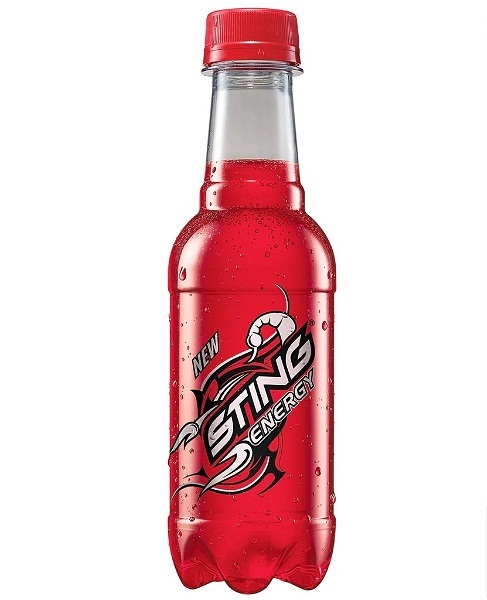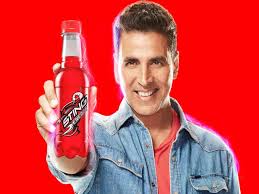Sting Drink Caffeine Content: If are you a big fan of Sting Energy drink and want to know about Sting Drink caffeine content, then you are at the right place. Read the full article for complete information.
What is Sting Energy Drink?
Sting drink is an energy drink with an awesome refreshing taste and delicious flavor. Sting drink refreshes you and gives you an energy boost and also charges up to stay full of energy. Sting drink contains Caffeine, Ginseng, and Vitamin B with delicious flavor. It energizes the body.
Sting Drink Caffeine Content
As per the ingredients available in Sting drink, it is clear to say that the Caffeine in Sting 250ml is 72mg.
Read Also: Sting Energy Drink Nutritional Information
Understand Caffeine
Caffeine is a focal sensory system (CNS) energizer of the methylxanthine class. As a mild cognitive enhancer or eugeroic (wakefulness promoter) to improve alertness and attentional performance, it is primarily used for recreational purposes.
Caffeine acts by impeding confining of adenosine to the adenosine A1 receptor, which updates the appearance of the neural connection acetylcholine. Caffeine is able to bind to and inhibit its receptors due to its three-dimensional structure, which is comparable to that of adenosine. Caffeine additionally increments cyclic AMP levels through nonselective restraint of phosphodiesterase.
Caffeine is an unpleasant, white glasslike purine, a methylxanthine alkaloid, and is synthetically connected with the adenine and guanine bases of deoxyribonucleic corrosive (DNA) and ribonucleic corrosive (RNA).

It is tracked down in the seeds, natural products, nuts, or leaves of various plants local to Africa, East Asia, and South America, and assists with shielding them against herbivores and from rivalry by forestalling the germination of neighboring seeds, as well as empowering utilization by select creatures like bumble bees.
The most popular wellspring of caffeine is the espresso bean, the seed of the coffee plant. Individuals might drink refreshments containing caffeine to assuage or forestall tiredness and to work on mental execution. To make these beverages, caffeine is separated by soaking the plant item in water, a cycle called implantation.
Coffee, tea, and cola, all of which contain caffeine, are widely consumed worldwide. Nearly 10 million tonnes of coffee beans will be consumed worldwide in 2020. Caffeine is the world’s most generally consumed psychoactive medication.
Dissimilar to most other psychoactive substances, caffeine remains to a great extent unregulated and lawful in practically all regions of the planet. Caffeine is likewise an exception as its utilization is viewed as socially adequate in many societies and, surprisingly, empowered in others.
Caffeine has both beneficial and harmful effects on health. It can treat and forestall the untimely baby breathing issues bronchopulmonary dysplasia of rashness and apnea of rashness. It may have a modest protective effect against Parkinson’s disease and other diseases.
Read Also: Sting Energy Drink Ingredients in Details
Caffeine consumption can disrupt sleep or cause anxiety in some people, but it doesn’t affect everyone. Proof of a gamble during pregnancy is dubious; Pregnant women should drink no more than two cups of coffee per day, according to some authorities.
When a person stops using caffeine after taking it on an ongoing basis throughout the day, they run the risk of developing a mild form of drug dependence, which is accompanied by withdrawal symptoms such as drowsiness, headache, and irritability.
Resistance to the autonomic impacts of expanded circulatory strain and pulse, and expanded pee yield, creates with ongoing use (i.e., these side effects become less articulated or don’t happen following reliable use).
The Food and Drug Administration of the United States says that caffeine is generally safe. Poisonous dosages, north of 10 grams each day for a grown-up, are a lot higher than the common portion of under 500 milligrams each day.
The European Sanitation Authority revealed that up to 400 mg of caffeine each day (around 5.7 mg/kg of weight each day) doesn’t raise security worries for non-pregnant grown-ups, while admissions up to 200 mg each day for pregnant and lactating ladies don’t raise well being worries for the embryo or the bosom took care of babies.
Some espresso contains 80-175 mg of caffeine, contingent upon what “bean” (seed) is utilized, the way things are cooked (hazier meals have less caffeine), and the way things are ready (e.g., dribble, permeation, or coffee). As a result, 50–100 regular cups of coffee are required to reach the toxic dose. However, small amounts of pure powdered caffeine, which can be purchased as a dietary supplement, can be fatal.

Physical Performance of Sting Drink
Caffeine is a demonstrated ergogenic help in people. Caffeine works on athletic execution in high-impact (particularly high-intensity games) and anaerobic circumstances. Moderate portions of caffeine (around 5 mg/kg[58]) can further develop run execution, cycling and running time preliminary execution, perseverance (i.e., it postpones the beginning of muscle weariness and focal weakness), and cycling power yield.
Caffeine increments basal metabolic rate in grown-ups. Fat oxidation is sped up when caffeine is consumed before aerobic exercise, especially in less fit people. Caffeine works on solid strength and power and may improve strong perseverance.
Additionally, caffeine improves performance on anaerobic tests. Caffeine utilization before consistent burden practice is related to decreased apparent effort. Performance is significantly improved even though this effect is absent from exercise-to-exhaustion exercise.
This is consistent with caffeine lessening apparent effort since workout to-weariness ought to end at a similar place of exhaustion. Caffeine likewise further develops power yield and decreases time to the end in vigorous time preliminaries, an impact decidedly (yet not only) related to longer length work out.

Caffeine For Adults
For everybody of solid grown-ups, Wellbeing Canada instructs an everyday admission concerning something like 400 mg. A systematic review of caffeine toxicology conducted in 2017 found this limit to be safe.
Caffeine For Children
In sound kids, moderate caffeine consumption under 400 mg produces outcomes that are “unobtrusive and normally harmless”. As soon as a half-year-old, babies can use caffeine at the very rate as that of grown-ups.
Higher portions of caffeine (>400 mg) can cause physiological, mental and social mischief, especially for youngsters with mental or cardiovascular circumstances. Coffee consumption does not appear to impede a child’s growth.
The American Institute of Pediatrics suggests that caffeine utilization isn’t proper for kids and teenagers and ought to stay away. This suggestion depends on a clinical report delivered by the American Foundation of Pediatrics in 2011 with a survey of 45 distributions from 1994 to 2011 and incorporates inputs from different partners (Pediatricians, Board of Trustees on nourishment, Canadian Pediatric Culture, Places for Infectious Prevention and Counteraction, Food and Medication Organization, Sports Medication and Wellness council, Public Leagues of Secondary School Affiliations).
Health Canada recommends a caffeine intake of no more than 2.5 milligrams per kilogram of body weight per day for children under the age of 12. In light of the normal body loads of kids, this means the accompanying age-based consumption limits.

